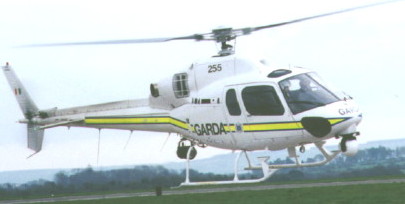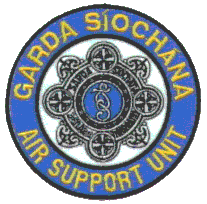|
|
|
 | |  | |
Garda Air Support Unit
|
 | |  | | |
THE GARDA AIR SUPPORT UNIT

The Garda Air Support Unit Helicopter
|
Besides being the 75th anniversary of the foundation of the Garda Síochána's, 1997 will also be remembered by the force as the year in which we received our first aircraft.
Andy Needham, editor of the
Garda Review magazine wrote the following article about the new unit and it's aircraft. The article which he has kindly donated was first published in the February 1997 issue of the Garda Review.
FORCE TAKES TO THE SKIES
by Andy Needham
|
The Garda Síochána is to receive an Air Support Unit comprising a helicopter and a fixed-wing aircraft. Andy Needham takes a look at the aircraft that, at a cost of £5.5 million, will bring the Force into the skies and into the next century.
 The newly established Garda Air Support Unit, as it is to be officially known comprises a helicopter and a fixed wing aircraft - at a cost of £5.5 million. The helicopter contract has been awarded to
Eurocopter International for its
AS355N Twin Ecureuil. The fixed-wing aircraft will be the
Pilatus Britten-Norman Defender 4000.
The unit should be in full flight by the summer.
The newly established Garda Air Support Unit, as it is to be officially known comprises a helicopter and a fixed wing aircraft - at a cost of £5.5 million. The helicopter contract has been awarded to
Eurocopter International for its
AS355N Twin Ecureuil. The fixed-wing aircraft will be the
Pilatus Britten-Norman Defender 4000.
The unit should be in full flight by the summer.
Both aircraft will be piloted by Air Corps pilots, while the Force will provide specially trained observers.
While some members of the Force who have undertaken flying lessons at their own expense in the past may feel
aggrieved that they won't get a shot at being the Force's answer to 'Top Gun', the research programme that was
initiated over 18 months ago never made any provision or indication that pilots would be chosen from the ranks
of the Force. As well as drawing pilots from the Air Corps, it is believed that all aspects of the maintenance
of the aircraft will be handled by the Air Corps. Twenty-five members of the Force have already attended a
suitability course at Templemore, and it is believed that this shortlist will be whittled down to a final unit
of 12, which would allow for a three shifts per day system to be initiated when the unit is up and running from
its base at Baldonnel. While it is not beyond the realms of possibility, there are no plans to use either
aircraft for parachuting purposes.
While such units are, by their nature expensive (it is estimated that the cost of running a helicopter such as
the AS 355 N is in the region of £800-£1000 an hour), the versatility and range of operations capable of being
carried out with air support mean that helicopters and planes have become a routine part of many police forces'
day to day operations. While some cynical wags have suggested that the helicopter is likely to be used to ferry
the Commissioner to Templemore for graduation ceremonies, the reality is that the air support unit is far too
valuable a commodity to be used in such a manner. In fact, a helicopter's engine life is not so much determined
by the number of hours flown, but rather on the number of 'startups' it has had.
The plane and the helicopter will have very different functions to perform, but their raisons d'Ítre can be
summed up as search and surveillance. The nature of the work undertaken by each is dictated by their respective
manoeuvrability and range. During a pursuit operation, following bank raiders for example, the role of the
supporting aircraft is simply to keep ground forces in touch with what's happening on the ground, and to give
the appropriate directions. The helicopter will come into its own in situations of crowd control and traffic
management. It is envisaged that it could even be used to help divert traffic and people at large scale events
like the All-Ireland Final. A helicopter can also be used during operations where radio contact is impossible -
in the mountains for example. By using the 'chopper as a relay point, full radio coverage is possible.
THE AS 355 N SQUIRREL
The latest addition to the twin-engine Squirrel family, the AS 355 N is a helicopter ideally suited to police work. Five police forces have already adopted it in the UK. The Dyfed-Powys were the first to purchase one, quickly followed by the London Metropolitan Police, who bought two, the East Midlands Air Supports Unit and the Lancashire Constabulary. The major attractions of the AS 355 N are the high power provided by its two Turbomeca Arrius 1A turboshafts, which develop a maximum takeoff power of 570 shp (420 kW), the low vibration level (noise is always a complaint from residents over whose houses many helicopters pass), and the spacious uncluttered cabin that allows mission-specific equipment to be integrated while retaining excellent visibility. The equipment provided for police work in Britain usually comprises a thermal imaging camera and TV camera package mounted under the machine's nose, to which night searchlights and loudhailers can be attached. All AS 355 Ns used by police forces feature a purpose built instrument panel combining high levels of visibility with ergonomic placement of controls and the TV monitor. The Greater Manchester Police have recently pioneered the use of a radio video down-link that transmits images from the nose mounted thermal imager back to the police control room. This equipment has also been adopted by the Met Police. The AS 355 N first appeared in the UK five years ago and has since logged nearly 7500 flying hours. The AS 355 N Squirrel has a maximum takeoff weight of 2,540 kg in internal payload configuration, and 2,600 with a cargo sling. Its cruise speed is 235 Km/h (127 kts), fuel capacity is 577 kg, while hourly fuel consumption is 180 kg/hr. Its range is 720 km (388 nm) and its maximum endurance at 100 km/hr is five hours. It can accommodate one pilot and between four and six passengers, but this depends on the tactical equipment onboard. It is believed that the fit-out specifications requested by the Force were quite high, and will include all the latest communications equipment, including encrypted radio links. It should also be fitted with a PA system, search light, TV camera, night vision facilities, microwave down-link for images, stabilised binoculars and the latest in computerised moving map technology. It is also understood that the helicopter will have some form of light armour under the seats and around the engine bay, to protect both it and its crew from ground fire. It may also have a wire strike protector, which lessens the chances of the rotors becoming snagged in overhead power lines.
Click here for Eurocopter's webpage on the AS355N Ecureuil
Click here for Eurocopter Canada's webpage on the AS355N Ecureuil
Click her for AEROSPATIALE page on the AS355N Ecureuil
THE PBN DEFENDER 4000
The Defender, PBN's most recent development, was launched at the Farnborough International Air Show in 1994, and is based on the highly successful and proven Defender series of aircraft. The Defender is larger than one of its sister aircraft, the Islander, which will be familiar to anyone who has flown to the Aran Islands, as this is the aircraft used by Aer Arann. The Islander is renowned for its ability to land 'practically anywhere', and the Defender continues that tradition. Indeed the Cheshire police force, currently being featured on Sky television's 'Coppers' documentary series, have an Islander at their disposal.
The Defender is a high wing monoplane of metal construction and fixed tricycle undercarriage - rugged and simple to maintain. Its fuselage is rectangular in section and is manufactured from aluminium alloys. The aircraft structure is designed to have exceptional fatigue life (over 40,000 hours) and all aircraft parts are protected against corrosion. The high wing configuration provides a maximum unobstructed field of view. It is designed to meet the most demanding surveillance requirements, and it maintains the benefits of low operating costs and durability. Its design evolution includes an extended fuselage giving increased cabin space, a nose cone that accommodates a 360o rotating antennae,
larger wing and an enhanced visibility cockpit with 240o of vision. Inside the Defender can accommodate a maximum of 16 people, or a combination of seats and computer consoles.
Its maximum takeoff and landing weight is 8500lbs (3855kg), while its maximum payload with a full fuel load is 1598lbs (724kg). It can reach heights of 25,000 feet, although its preferred operational height will probably be between 12,000 and 14,000 feet, and has a maximum cruise speed of 176 knots (326kph). Its short takeoff and landing capability means that the Defender will be able to land a number of airfields across the country. Its range of 1006 nautical miles (589m) makes it ideal for covert operations at sea - monitoring suspected drug running vessels etc. To give you an idea of the distance you could travel in the Defender, you could fly from Dublin to Galway and back five times on one load of fuel.
Click here to visit the PBN Website for further information.
Reproduced by the kind permission of
Andy Needham, Editor of the Garda Review.
Copyright
Garda Review Magazine - © February 1997
|
|
|  | |  |
|
|
|
 |
|
 |
This website is for information and recreation purposes only. While every effort has been made to ensure that the information in this site is true, errors and omissions are inevitable and the authors and webmaster of this site herein disclaim themselves from any responsibility.
|
|
|